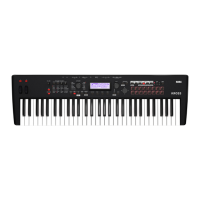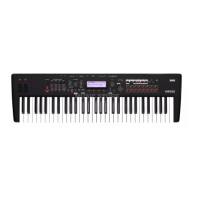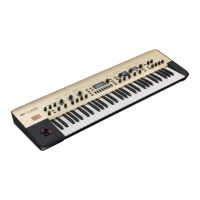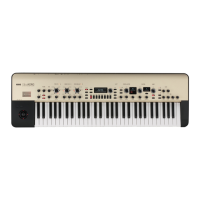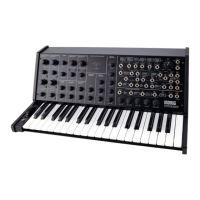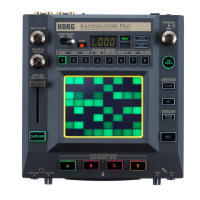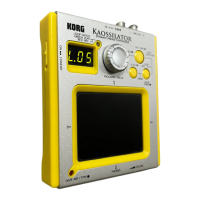Playing and editing Programs
32
2. Select Stereo as the Multisample Bank for
multisample1 and multisample2.
There are two main types of Multisample Banks: Mono,
and Stereo. Note that stereo Multisamples will require
twice as many voices as mono Multisamples.
3. Select the multisample.
Multisamples are organized by category such as piano,
guitar, bell, etc. Choose the Multisample Select parameter
and press the ENTER button to see the list. Use the cursor
buttons ◄► to switch categories, use the cursor buttons
▼▲ to select a multisample, and press the ENTER
button to confirm your choice.
4. In the same way, select multisample 2 in the P-OSC>
MS2 page. Select a different Multisample than what
was selected for multisample1.
Multisamples have now been assigned to multisample 1
and 2.
5. Specify the velocity range and crossfade range.
Set the multisample 2 “Threshold Velocity” to 001, and
turn “Crossfade” Off.
6. In the P-OSC> MS1 page, set the velocity range
(Bottom Vel.) to 80 for multisample 1.
With these settings, Multisample2 will sound for notes
played with a velocity of 79 or less, and Multisample1
will sound for notes played with a velocity of 80 or
greater.
The Velocity Zone shows the oscillator’s four
multisamples and the velocity zones of each oscillator.
The meter on the left shows the note-on velocity. This lets
you see which multisample and oscillator will sound for
that specific velocity.
7. Set the multisample 1 “Xfade” to 20, and its “Curve”
to Linear.
The state of this split is shown visually in the screen.
The two multisamples will fade across the range from 80
to 100, with multisample 2 fading-out while multisample
1 fades-in. This produces a smooth change without any
sudden switch.
8. As needed, use the P-OSC> MS1 page and MS2 page
to adjust the Level of the two multisamples.
Using a drum kit
What is a drum kit?
A drum kit is a collection of drum set samples such as bass
drum, snare, or cymbal, as well as a variety of other
percussion sounds, with a sample assigned to each key.
You’ll use Global mode to create and edit a drum kit. Up to
four drum samples can be assigned to each note of the
keyboard, and you can use the BottomVel., Xfade, and
Curve parameters to specify how you’ll switch between
these samples. Then, in Program mode, you can adjust filter
and amp settings, and specify effects and routing to the audio
output jacks. (see page 93)
To use a drum kit in a Program, set Oscillator Mode to
Drums, and choose one of the 48 user drum kits or the 9
GM2 drum kits.
Selecting a drum kit
1. Access the P-BASIC> VOICE page.
2. Set “OSC (Oscillator Mode)” to Drums.
3. Select a drum kit in the P-OSC> DKit page.
4. Specify the basic pitch of the oscillator. For a drum
kit, set “Octave” to +0 [8'].
